There is an ever-increasing number of breakfast cereals on the market, with more choices that are high in nutrients and low in sugar. However, it can be difficult to pick these out amongst all the sugary options you see on the shelves – Lucky Charms, Frosted Flakes, and Cocoa Puffs, etc. Even seemingly healthy cereals, you are not supposed to trust everything you see on the front of the box.
To help you understand more about cocoa puffs nutrition facts, here is a guide to the nutrients you'll find in a typical serving. We'll also show how you can make your own healthier version of this tasty cereal. Finally, there's some advice on what cereal to look for when you're planning your breakfast.
Cocoa Puffs Nutrition Facts
|
Serving: 27 g (3/4 cup) |
|
|
Nutrition |
Amount Per Serving |
|---|---|
|
Calories |
100 |
|
Total Fat |
1.5 g |
|
Cholesterol |
0 mg |
|
Sodium |
150 mg |
|
Potassium |
70 mg |
|
Total Carbohydrate |
23 g |
|
Protein |
1 g |
Notes: For the 100 calories, you will find 15 of them from the fat. In the 1.5g total fat, 0.5g is polyunsaturated fat and 0.5g is monounsaturated fat. For the 23g total carbohydrate, 2g is dietary fiber and 10g sugar is also contained in that.
How to Make Cocoa Puffs at Home
 Ingredients
Ingredients
- 1 cup gluten-free flour blend
- ½ cup cocoa powder
- 2 teaspoons vanilla extract
- 1 whole egg/Chia gel (leave 1 tablespoon chia seeds in 3 tablespoons water for 10 minutes)
- 1 tablespoon semi-soft coconut oil/ghee/butter
- ¼ teaspoon salt
- 3-4 tablespoons maple syrup/coconut nectar/honey
Directions
- Preheat your oven to 375°F.
- Start to pulse all the ingredients except the maple syrup in a food processor.
- Gradually add in the maple syrup in tablespoons.
- Keep pulsing on the dough until a mixture is formed. It may appear crumbly, but it should roll nicely. If not, add some more maple syrup.
- Roll your mixture into grape-sized balls.
- Bake these balls for 15-18 minutes.
- Cool the cocoa puffs. Now they're ready to eat!
What to Consider When Choosing Cereals
Aside from the cocoa puffs nutrition facts, there are certain things you should know about choossing cereals for your diet. Below are 4 useful tips for you.
1. Check the Sugar Content
Look at the nutritional information on the side of the box. Here, the number of grams of sugar is listed. Ensure you calculate the sugar content in one serving according to your diet habits.
Besides, some companies will advertise high fiber content in the cereals, making people feel it is a healthy choice. Yet, that fiber usually goes along with high content of sugar. So you need to compare the sugar content with the whole serving size.
Total sugar also includes fruit sugars, for example from sultanas, which are ok to eat. Look carefully at the ingredients to see where the sugar in the cereal comes from.
2. Go for Cereals High in Whole Grains
Whole grains are great choice. Look for whole grain oats or whole grain wheat as the first or second ingredient in the ingredients list, and avoid refined grains, such as rice and rice flour.
Compare the whole grain grams per serving with the serving size. If these figures are similar, the cereal will be rich in whole grain. However, if it's not, look at the other ingredients to see if they are healthy nutrients, such as nuts, fruit, bran and soy.
3. Watch Out for Fiber Claims
When choosing a cereal, it's better to look for whole grains rather than fiber content. There are different types of fiber – some are beneficial and some are not. Choose cereals with intact fibers from bran or whole grains, and avoid isolated fibers, including corn fiber, oat fiber and soy fiber. These fibers have been taken from grains and processed into a powder, losing any health benefits. For a healthy breakfast, pick a cereal filled with whole grains that has low sugar content.
4. Don't Fall for False Health Statements
There are certain claims on cereal boxes you should be suspicious of:
- Yogurt clusters – A yoghurt coating is made from sugar and oil.
- Low in saturated fat – Most cereals are low in saturated fat, but they may be full of sugar.
- Slimming – Cereals' weight-loss claims are just not backed up by the evidence.
- Low in calories – Cereals are generally calorific, so watch your serving sizes.
- Artificial fruit – Check to see if the fruit in your cereal is real or not, and not full of processed ingredients
